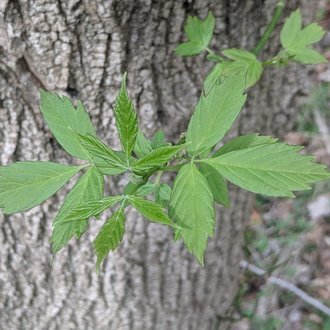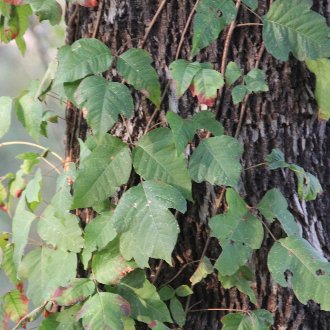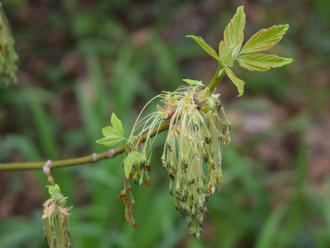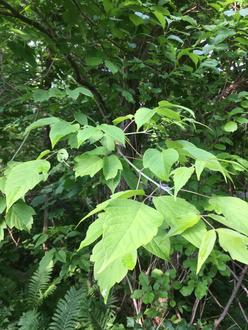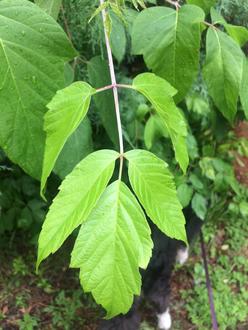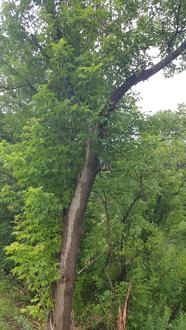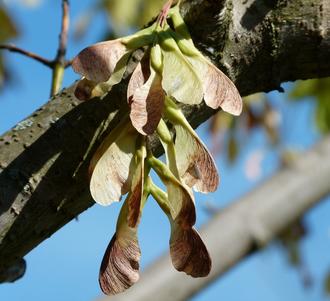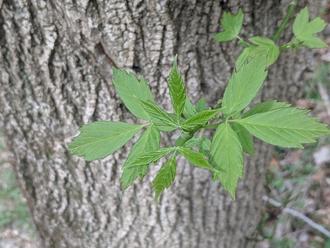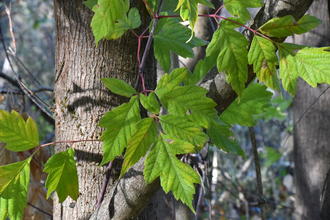Box Elder (Acer negundo L.)
Also known as Boxelder, Ash-leaved Maple, Ashleaf Maple, Maple Ash, Manitoba Maple, Elf Maple.
↑Summary
A maple with compound leaves, native across North America, coast-to-coast, common in riparian areas and near wetlands.
↑Range - Expand
| Legend | Color |
| Native | |
| Native or Not Present |
This tentative map is based on our own research. It may have limited data on Canada and/or Mexico, and there is some subjectivity in our assignment of plants as introduced vs. expanded. Read more in this blog post.
Although this plant occurs somewhere in each of these regions, it may only occur in a small part of some or all of them.
↑Description & Identification
A small to large tree with an irregular form. May grow with a single-trunk habit, especially if growing among other trees, but often branches extensively near the ground. New growth of twigs are green and oven glaucous. Opposite leaves are compound, with 3-5 (occasionally as many as 9) leaflets. Leaflets serrated or sometimes variably lobed; eastern trees have more rounded serrations, but populations in the southwest have deeper, sharper serrations or lobes. Foliage pale light green, sometimes yellowish. Petioles often have a pinkish to reddish tinge.
Distinctive among maples in its range due to its compound leaves, Box Elder is most often confused with other less-closely-related plants.
↑Similar Plants
↑Habitat
Box elder is found in a wide range of conditions. It is most common in floodplains and riparian forests, where it is sometimes a dominant plant. In the more humid, eastern parts of its range, it is occasional in upland habitats, where it is less common and more limited to disturbed, high-light sites.
It is tolerant of flooding, and drought-tolerant once established. It tolerates a wide range of soil types and textures. However, it prefers well-drained soils.
It tolerates some light shade, and is most frequently found in partly-wooded habitats where there is some light shade from other trees, but it does not reproduce in its own shade, and usually not in closed-canopy forests in general.
Occupies different stages in succession in different regions. In more arid regions, often forms a stable climax species, a canopy dominant in riparian areas. In the more humid east, occupies an earlier stage of succession, eventually being replaced by more shade-tolerant species.
↑Life Cycle
Seeds germinate in spring after a period of cold dormancy. Seedlings can germinate in exposed soil following disturbance, but can also establish under existing vegetation.
Growth is rapid, often 2 feet or more per year. The root system is usually shallow and spreading, but may become deeper if the soil allows.
Seed production is consistent every year. Seeds are primarily dispersed by wind, but also by animals. Seeds often fall in winter where they spread longer distances across the surface of snow, than they would without snow cover in a forested landscape.
Trees typically live 75 years, but may live as long as 100, making this a relatively short-lived species. Older branches become brittle and break easily.
Vegetative reproduction is common and trees will resprout heavily if damaged.
↑Uses
The wood of this species is largely undesirable. It is soft and low in strength, and also makes poor firewood. It is occasionally used for cheap, rough purposes.
This species is rarely used as a landscaping plant, where it is valued for its rapid growth and resistance to drought, cold, and urban conditions. It is typically avoided due to its sprawling, irregular growth habit, often producing abundant suckers when planted in a yard or as a street tree, its brittle wood and tendency to drop branches, and its propensity to attract large numbers of box-elder bugs, which often come into homes.
The sap has a high sugar content and can be used to produce syrup like that of the sugar maple.
↑Related Plants
Numerous other Acer (maple) species are found in North America, both native and introduced, and many co-occur with box elder in the same habitat.
However, box-elder is not closely related to most of these species, having diverged from them earlier in its evolution, in the mid-to-late Eocene, which ended 33.9 million years ago. It is thought to be most closely related to the bigleaf maple (Acer macrophyllum), native to the West Coast of North America and overlapping in range.
↑Notes
Some of its common names reference its superficial similarity to ash trees, with which it shares the characteristics of oppositely-arranged compound leaves.
↑Links & External Resources
• Box Elder | The Wood Database (About This Site)
• Boxelder | Fire Effects Information System (FEIS) (About This Site)
• Acer negundo (Box Elder) | Illinois Wildflowers (About This Site)
• Acer negundo (Box Elder) | USDA PLANTS Database (About This Site)
• Acer negundo | Go Botany (About This Site)
• Acer negundo (Boxelder) | Missouri Botanical Garden Plant Finder (About This Site)
• Boxelder | Virginia Tech Dendrology Factsheets (About This Site)
• Boxelder | Silvics of North America (About This Site)
• Acer negundo | Biota of North America Project (BONAP) (About This Site)
• Acer negundo | NatureServe Explorer (About This Site)
• Box Elder | Maryland Biodiversity Project (About This Site)
• Acer negundo L. var. negundo (Boxelder, Eastern Boxelder) | Digital Atlas of the Virginia Flora (About This Site)



